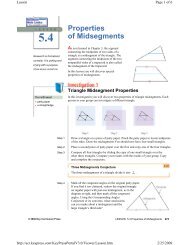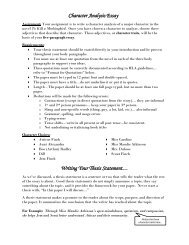Medieval Europe and the Ottoman Empire - Redmond School District
Medieval Europe and the Ottoman Empire - Redmond School District
Medieval Europe and the Ottoman Empire - Redmond School District
You also want an ePaper? Increase the reach of your titles
YUMPU automatically turns print PDFs into web optimized ePapers that Google loves.
The Crusades<br />
Build on What You Know In Chapter 4, you read about<br />
how <strong>the</strong> Seljuk Turks took control of Palestine <strong>and</strong> came into<br />
conflict with Orthodox Christians of eastern <strong>Europe</strong>. In Lesson 2,<br />
you will read more about that conflict.<br />
Battle for Palestine<br />
ESSENTIAL QUESTION Why did <strong>the</strong> Christians begin a series of wars to<br />
conquer Palestine?<br />
The Crusades were military expeditions from Christian <strong>Europe</strong> to<br />
Palestine between <strong>the</strong> 11th <strong>and</strong> 13th centuries. They had a lasting<br />
impact on <strong>Europe</strong>an politics <strong>and</strong> society.<br />
Causes of <strong>the</strong> Crusades <strong>Europe</strong>an Christians began <strong>the</strong><br />
Crusades for several reasons. Jerusalem <strong>and</strong> <strong>the</strong> area around it was,<br />
<strong>and</strong> still is, sacred to Christians, Jews, <strong>and</strong> Muslims. Christians called<br />
this area <strong>the</strong> Holy L<strong>and</strong>. The Seljuk takeover of Jerusalem in 1071<br />
made Christian pilgrimages to <strong>the</strong> Holy L<strong>and</strong> nearly impossible.<br />
Additionally, <strong>Europe</strong>an feudal princes often used success<br />
in warfare as one way to gain power. As a result, many princes<br />
were eager to go on <strong>the</strong> Crusades. <strong>Europe</strong>an merchants were also<br />
willing to finance <strong>the</strong> Crusades because <strong>the</strong>y might gain access to<br />
<strong>the</strong> rich trade routes that connected with Asia to <strong>the</strong> east.<br />
Finally, Seljuk forces attacked <strong>the</strong> Byzantine <strong>Empire</strong>. The<br />
Byzantine emperor asked <strong>the</strong> pope for help. By 1096, <strong>the</strong> pope<br />
responded, <strong>and</strong> <strong>the</strong> First Crusade began (see map below).<br />
40°N<br />
30°N<br />
20°W<br />
ATLANTIC<br />
OCEAN<br />
GEOGRAPHY SKILLBUILDER<br />
INTERPRETING MAPS<br />
Movement Look at <strong>the</strong> route<br />
through Rome. How were <strong>the</strong><br />
travel needs of that group<br />
different from <strong>the</strong> o<strong>the</strong>rs?<br />
10°W<br />
First Crusade,<br />
A.D. 1096–1099<br />
SPAIN<br />
0°<br />
ENGLAND<br />
Paris<br />
HOLY ROMAN<br />
EMPIRE<br />
Regensburg<br />
Vezelay<br />
Venice<br />
Vienna<br />
FRANCE<br />
Belgrade<br />
Marseille<br />
10°E<br />
Rome<br />
W<br />
N<br />
BYZANTINE<br />
EMPIRE<br />
Mediterranean Sea<br />
S<br />
E<br />
Black Sea<br />
Constantinople<br />
Nicaea<br />
Jerusalem<br />
Antioch<br />
PALESTINE<br />
Christian l<strong>and</strong>s<br />
Muslim l<strong>and</strong>s<br />
First Crusade<br />
0 250 500 miles<br />
0 250 500 kilometers<br />
Damascus<br />
20°E 30°E 40°E<br />
TERMS & NAMES<br />
Seljuk Turk<br />
Crusade<br />
Saladin<br />
Reconquista<br />
Inquisition<br />
327








